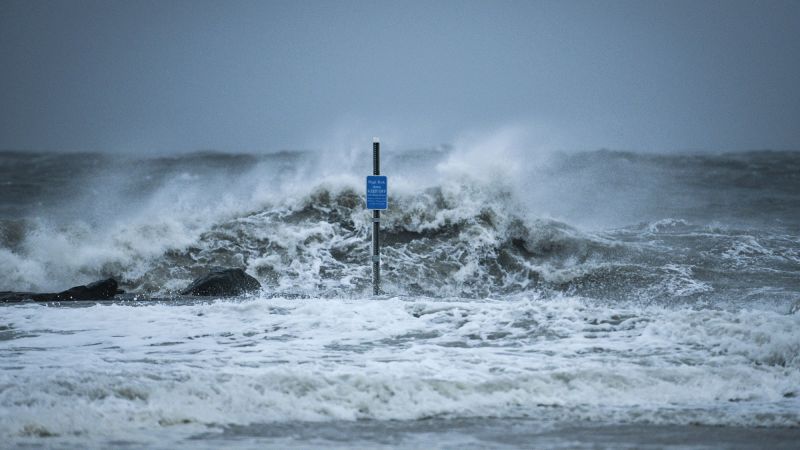Slowing Ocean Currents: Fueling US Sea Level Rise

Welcome to your ultimate source for breaking news, trending updates, and in-depth stories from around the world. Whether it's politics, technology, entertainment, sports, or lifestyle, we bring you real-time updates that keep you informed and ahead of the curve.
Our team works tirelessly to ensure you never miss a moment. From the latest developments in global events to the most talked-about topics on social media, our news platform is designed to deliver accurate and timely information, all in one place.
Stay in the know and join thousands of readers who trust us for reliable, up-to-date content. Explore our expertly curated articles and dive deeper into the stories that matter to you. Visit Best Website now and be part of the conversation. Don't miss out on the headlines that shape our world!
Table of Contents
Slowing Ocean Currents: Fueling US Sea Level Rise – A Growing Threat
The Atlantic Meridional Overturning Circulation (AMOC), a major ocean current system crucial for global climate regulation, is showing signs of weakening. This slowdown, according to recent studies, is significantly contributing to accelerated sea level rise along the US East Coast, posing a serious threat to coastal communities and infrastructure. The implications are far-reaching, demanding immediate attention and proactive mitigation strategies.
Understanding the AMOC and its Impact on US Sea Levels
The AMOC acts like a giant conveyor belt, transporting warm water from the tropics northward towards the North Atlantic. As this water cools and becomes saltier, it sinks, driving the circulation. This system plays a vital role in regulating global temperatures and influencing weather patterns. However, increasing global temperatures, fueled by climate change, are disrupting this delicate balance. Melting glaciers and ice sheets are introducing large amounts of freshwater into the North Atlantic, reducing the water's salinity and hindering the sinking process, thus weakening the AMOC.
This slowdown has a direct impact on sea level rise. A weaker AMOC means less warm water is being transported northward, leading to a build-up of water in the subtropics. This excess water, coupled with thermal expansion (water expanding as it warms), contributes to higher sea levels along the US East Coast, exacerbating the effects of already rising tides.
The Evidence Mounts: Scientific Findings and Projections
Numerous scientific studies have documented the AMOC's weakening. Research published in [insert reputable scientific journal and link here] indicates a significant slowdown in recent decades, with projections suggesting further weakening in the coming years. These findings are supported by observational data, including satellite measurements and oceanographic surveys. The consequences are stark:
- Increased coastal flooding: Higher sea levels lead to more frequent and severe coastal flooding, threatening homes, businesses, and critical infrastructure.
- Erosion and habitat loss: Rising sea levels accelerate coastal erosion, destroying beaches and wetlands, and impacting vital ecosystems.
- Saltwater intrusion: Saltwater intrusion into freshwater aquifers threatens drinking water supplies and agricultural lands.
- Economic impacts: The cumulative effects of coastal flooding, erosion, and habitat loss pose significant economic challenges, impacting tourism, fishing, and real estate.
What Can Be Done? Mitigating the Threat of Rising Sea Levels
Addressing the issue of slowing ocean currents and their contribution to sea level rise requires a multi-pronged approach:
- Reducing greenhouse gas emissions: This is paramount to slowing the pace of climate change and mitigating its impacts on the AMOC. Transitioning to renewable energy sources, improving energy efficiency, and adopting sustainable transportation are crucial steps.
- Investing in coastal resilience: Strengthening coastal defenses, developing early warning systems for flooding, and implementing nature-based solutions such as restoring coastal wetlands can help protect communities from rising sea levels.
- Improving scientific understanding: Continued research is crucial to better understand the dynamics of the AMOC and its response to climate change. This will improve our ability to predict future changes and develop effective mitigation strategies.
- International cooperation: Addressing climate change and its impacts requires global collaboration. International agreements and initiatives are vital for coordinating efforts to reduce emissions and adapt to the consequences of a changing climate.
Conclusion: A Call to Action
The slowing of ocean currents and the resulting acceleration of sea level rise along the US East Coast represent a serious and growing threat. Addressing this challenge requires immediate and sustained action, encompassing both mitigation of greenhouse gas emissions and adaptation to the inevitable changes already underway. Ignoring this threat will have severe consequences for coastal communities and the global environment. We must act now to protect our coastlines and ensure a sustainable future.

Thank you for visiting our website, your trusted source for the latest updates and in-depth coverage on Slowing Ocean Currents: Fueling US Sea Level Rise. We're committed to keeping you informed with timely and accurate information to meet your curiosity and needs.
If you have any questions, suggestions, or feedback, we'd love to hear from you. Your insights are valuable to us and help us improve to serve you better. Feel free to reach out through our contact page.
Don't forget to bookmark our website and check back regularly for the latest headlines and trending topics. See you next time, and thank you for being part of our growing community!
Featured Posts
-
 50 Cents Brutal Diss Targets Jay Zs Relationship With Diddy
May 18, 2025
50 Cents Brutal Diss Targets Jay Zs Relationship With Diddy
May 18, 2025 -
 Alleged Drug Smuggling American Basketball Star Arrested In Indonesia Death Penalty Threat Looms
May 18, 2025
Alleged Drug Smuggling American Basketball Star Arrested In Indonesia Death Penalty Threat Looms
May 18, 2025 -
 Amid Dating Rumors Tom Cruise Gives Ana De Armas Film A Rave Review
May 18, 2025
Amid Dating Rumors Tom Cruise Gives Ana De Armas Film A Rave Review
May 18, 2025 -
 The Subway Series Most Hated Mets And Yankees Players
May 18, 2025
The Subway Series Most Hated Mets And Yankees Players
May 18, 2025 -
 Beyond Negan Jeffrey Dean Morgan Opens Up About Destination X And Future Projects
May 18, 2025
Beyond Negan Jeffrey Dean Morgan Opens Up About Destination X And Future Projects
May 18, 2025
Latest Posts
-
 50 Cent Weighs In Cassies Testimony And Diddys Plea Deal
May 19, 2025
50 Cent Weighs In Cassies Testimony And Diddys Plea Deal
May 19, 2025 -
 Amidst Dating Rumors Tom Cruise Supports Ana De Armas Upcoming Film
May 19, 2025
Amidst Dating Rumors Tom Cruise Supports Ana De Armas Upcoming Film
May 19, 2025 -
 Top Shows And Movies For Recent Graduates This Weekend
May 19, 2025
Top Shows And Movies For Recent Graduates This Weekend
May 19, 2025 -
 Understanding Red Carpet Behavior Why Guests Break The Rules
May 19, 2025
Understanding Red Carpet Behavior Why Guests Break The Rules
May 19, 2025 -
 Cassie Venturas Testimony The Turning Point In Diddys Case
May 19, 2025
Cassie Venturas Testimony The Turning Point In Diddys Case
May 19, 2025
